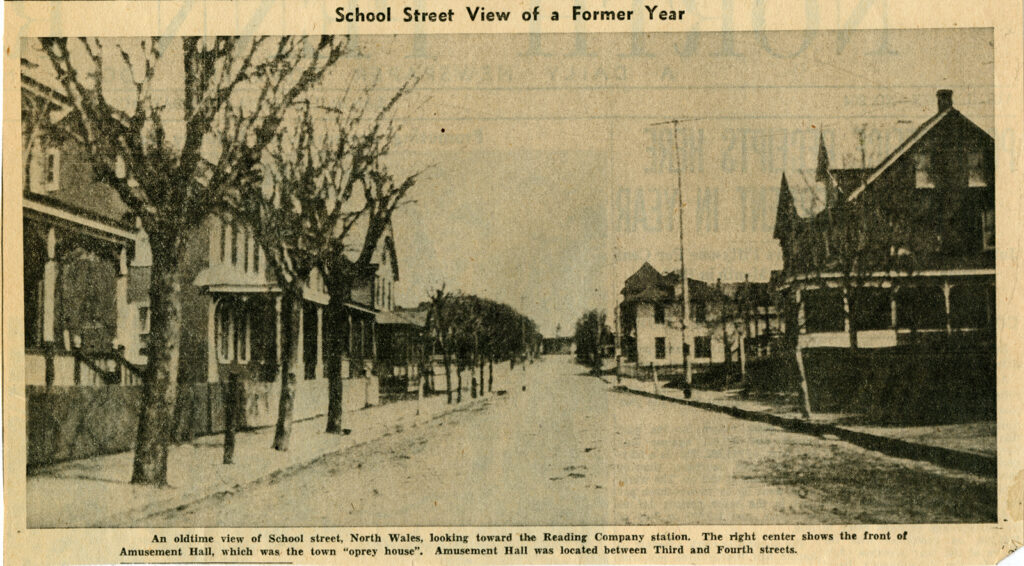After the incorporation of North Wales Borough and the granting of the charter by Montgomery County Court we find the following entry in the borough minutes:
“At an election held at the Public House of Abel Lukens in the Borough of North Wales on the 21st day of September, 1869, by virtue of and in pursuance of the decree of the Court of Quarter Sessions of the County of Montgomery of the 20th day of August, 1869, the following persons were duly elected to fill the offices provided for by law, to-wit:
Burgess – George Schlotterer
Town Council – Henry F. Moyer, Elias K. Freed, Percival Slough, Joseph K. Anders and George Cathrall
Constable – Noah W. Weikel
Judge of Election – Augustus W. Dettra
Inspector – George W. Nyce (There being a tie vote for Abel Lukens and John S. Knight for Inspector)
Assessor – Daniel Kenderdine
Auditor – Henry W. Moyer
School Directors – George Schlotterer, William Wilson, Dr. B. K. Johnson, Leidy Gerhart, Isaac G. Freed and John Kline
Justice of the Peace – Isaac W. Wampole and David Moyer
The public house of Abel Lukens was what is now the Rorer-Seems Building, and Lukens’ Hall, which is mentioned very often in these articles, is the building which now [1959] contains the U. S. Post Office.
We do not intend to quote verbatim every minute contained in the records of Borough Council, but not to give the full record of the first meeting would take from these articles the very purpose for which they are written. Therefore, again we quote:
“The first meeting of the Town Council of the Borough of North Wales was held in Lukens’ Hall on Wednesday evening, September 29th, 1869, when the following members were present: George Schlotterer Burgess; Elias K. Freed, Henry F. Moyer and Percival G. Slough, members of the Council, all of whom having been previously duly sworn or affirmed according to law before, Algernon S. Jenkins, Esquire, a Justice of the Peace. Joseph K. Anders, also a member of Council, was present, being duly affirmed by George Schlotterer, Burgess.
“Whereupon council organized by choosing Henry F. Moyer president, and unanimously elected lsaac W. Wampole, Clerk, and appointed Abel K. Shearer, borough treasurer.
“Being thus organized, it was on motion resolved that Elias K. Freed and Joseph K. Anders, who having received the highest number of votes at the late election held on the 21st day of September 1869, should remain in office until their successors are elected in October, 1870, and come regularly into office, and that three persons be elected to the office of Town Council on Tuesday, October 12, 1869, to serve for a term two years.
“On motion Elias K. Freed was appointed a committee to procure the necessary books and stationary for the use of the council.”
Of course, no borough could function without a street commissioner and surveyor, and accordingly, on October 6th, 1869, Frederick Wolf and Ellwood Cleaver were appointed commissioner and surveyor respectively.

Council again met on October 18th, 1869, at which time they appointed Henry F. Moyer as a committee on Finance with instructions to borrow two hundred dollars on Borough Scrip. At this meeting Council was also informed of the bad condition of the bridge at Main and Walnut streets. The mention of a bridge at this intersection causes one to visualize a wooden structure across the street, but in searching records and talking to residents of the town “whose memories runneth not to the contrary” we find that the “bridge” was simply a wooden culvert over a large ditch which existed at Main and Walnut streets at that time.
On the 12th of October 1869, or about one month after the special election held on September 21st of the same year, a general election was held at the Public House of Abel Lukens, at which time the following persons were duly elected Borough officers for the ensuing term: burgess, Isaac Wampole, Jr.; town council, Henry F. Moyer, Percival Slough and David Smith, Jr.; constable, Noah W. Weikel.
In passing we want to pay tribute to the memory of the man who was the second Burgess of North Wales, Isaac W. Wampole, Jr. Mr. Wampole was elected burgess in 1869 and for many years served this community in an official capacity. He performed the duties of his various offices faithfully and loyally, always having in mind the trust imposed upon him by the people. He was one of the pioneers in the building of the town and lived within its confines for many years. Mr. Wampole left a long line of descendants, many of whom are our present day citizens.
The father of Mr. Wampole, Isaac W. Wampole, served this town as borough clerk for a period of twenty years and the minutes kept by him are the most comprehensive, as well as the most beautifully written, that we have ever seen. It is only through his detailed recordings of the actions of the early councils that these present articles are possible.
This post is sourced from a column entitled Early North Wales: Its History and Its People penned by long-time North Wales resident historian Leon T. Lewis. The article appeared in its original form in the August 11, 1959 issue of the North Penn Reporter.
